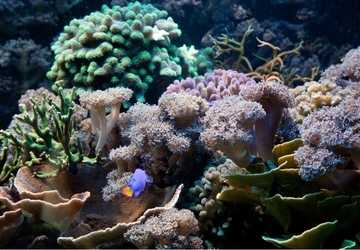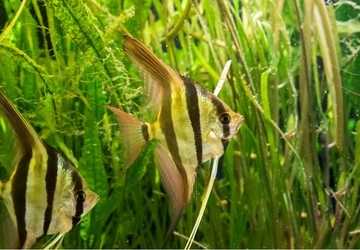Aquatic plants are more than just decorative elements in a freshwater aquarium. They offer a multitude of benefits, including improved water quality, enhanced aesthetics, and a natural habitat for your aquatic pets. However, introducing and maintaining aquatic plants in your aquarium can be a bit tricky if you're not sure where to start. In this comprehensive guide, we will walk you through the steps of introducing aquatic plants to your freshwater aquarium, from choosing the right plants to maintaining them for long-term success.

Choose the Right Plants
Selecting the right aquatic plants is crucial for a successful freshwater aquarium. Not all plants are suitable for every tank, so take the time to research and make informed decisions. Here's how to do it:
a. Research Your Aquarium Type
The type of aquarium you have will influence your plant choices. For example, low-light plants are ideal for beginners with standard aquarium lighting, while high-tech setups with strong lighting and CO2 supplementation can accommodate more demanding species. Consider whether you have a low-tech or high-tech tank, as this will help narrow down your options.
b. Start with Hardy Plants
If you're new to aquarium gardening, opt for hardy plants that are forgiving of beginner mistakes. Some popular choices include Java Fern, Anubias, and Java Moss. These plants are adaptable and can thrive in various water conditions.
c. Consider Your Aquarium Size
The size of your aquarium matters when choosing plants. Smaller tanks may require more compact plants, while larger tanks can accommodate taller, more substantial species. Always keep the growth potential of your chosen plants in mind to prevent overcrowding.
Prepare Your Aquarium
Before adding any plants, ensure your aquarium is ready to support aquatic plant life. Here are some steps to follow:
a. Install Proper Lighting
Lighting is crucial for plant growth. Depending on your chosen plant species, you may need low, medium, or high-intensity lighting. Make sure your aquarium's lighting setup matches the needs of your plants. Full-spectrum LED lights are a popular choice for their energy efficiency and plant-friendly wavelengths.
b. Substrate Selection
Aquatic plants need a suitable substrate to anchor their roots and access essential nutrients. Consider using specialized plant substrates, such as aquatic plant soil or sand, to create an optimal environment for root development. Ensure the substrate is well-rinsed to prevent cloudiness in the water.
c. Add Fertilizer
Supplement your plant's nutrient needs with a liquid fertilizer designed for aquatic plants. This is especially important in low-tech setups where nutrients may be limited. Be mindful not to over-fertilize, as this can lead to algae issues.
Planting Your Aquatic Plants
Now that your aquarium is properly prepared, it's time to introduce your chosen plants. Follow these steps for successful planting:
a. Plan Your Layout
Before planting, envision the layout of your aquarium. Arrange your plants according to size, ensuring a balance between foreground, midground, and background plants. Leave some open spaces for swimming and hiding spots for your aquatic pets.
b. Prepare the Plants
Trim any damaged or excess leaves and roots from your plants. This not only ensures a neat appearance but also encourages healthy growth. For stem plants, consider making cuttings to encourage branching and faster growth.
c. Planting Techniques
Carefully insert your plants into the substrate while taking care not to damage the roots. Use planting tools like tweezers or specialized planting tongs for precision. Ensure that the plants are securely anchored to prevent them from floating to the surface.
d. Allow for Growth Space
Leave adequate space between plants to accommodate their growth. Crowding can lead to poor circulation and light blockage, resulting in unhealthy plants.
Maintenance and Care
Once your aquatic plants are in place, regular maintenance is essential to keep them thriving and your aquarium looking its best. Here's what you need to know:
a. Water Changes
Regular water changes are crucial to maintain water quality and remove excess nutrients. Aim for weekly water changes of 20-30% of your tank volume. This helps prevent algae blooms and promotes plant growth.
b. Pruning and Trimming
Aquatic plants will grow, and some faster than others. Prune and trim your plants as needed to maintain the desired appearance and prevent overgrowth. This is also an excellent opportunity to remove any dead or decaying plant matter.
c. Algae Control

Algae can be a nuisance in aquariums. To control its growth, maintain consistent lighting and nutrient levels, avoid overfeeding your fish, and consider introducing algae-eating species like nerite snails or Siamese algae eaters.
Address Common Challenges
While maintaining aquatic plants can be rewarding, challenges may arise. Here are some common issues and how to address them:
a. Algae Growth
Algae can overtake your plants if left unchecked. To combat algae, adjust your lighting, reduce nutrient levels, and introduce algae-eating creatures. Be patient; it may take time to find the right balance.
b. Yellowing or Dying Leaves
Yellowing or dying leaves can be a sign of nutrient deficiency. Adjust your fertilization regimen, ensuring your plants receive the necessary nutrients to thrive.
c. Invasive Plants
Some aquatic plants can be invasive and take over your aquarium. Regularly thin out and remove any plants that are growing too aggressively.
Conclusion
Introducing aquatic plants to your freshwater aquarium can be a rewarding endeavor, providing your fish with a natural and enriching environment while enhancing the overall aesthetic appeal of your tank. By selecting the right plants, preparing your aquarium adequately, and following a regular maintenance routine, you can create a thriving underwater garden that both you and your aquatic pets will enjoy.
Every aquarium is unique, and you may need to adjust your care routine based on the specific needs of your plants and fish. With time and patience, you'll master the art of aquascaping, creating a harmonious and visually stunning aquatic ecosystem in your home. So, dive into the world of aquatic plants and watch your freshwater aquarium come to life with vibrant greenery and tranquility.








